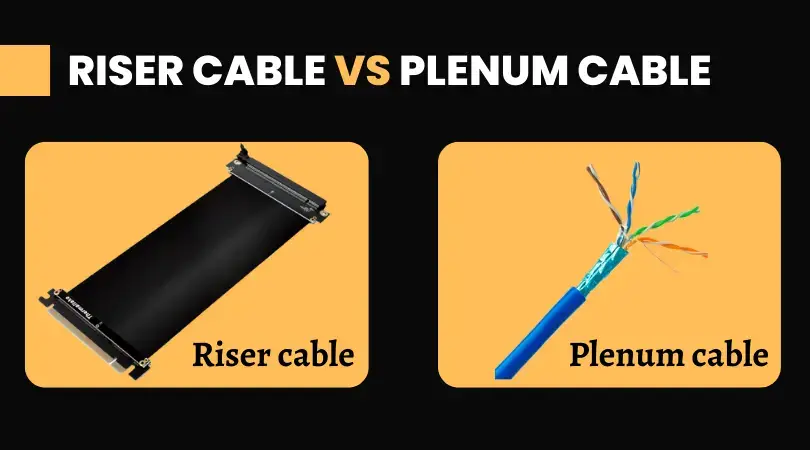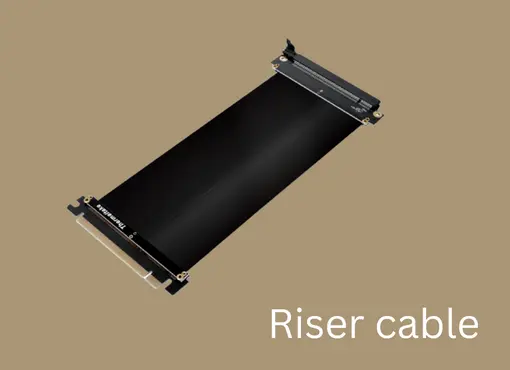Riser vs Plenum Cable: Detailed Information and Comparison

Affiliate Disclaimer
As an affiliate, we may earn a commission from qualifying purchases. We get commissions for purchases made through links on this website from Amazon and other third parties.
Related Read: Best Cat 8 Ethernet Cable for Gaming
The distinction is what’s on the outside of the cable, the outer jacket that protects the cable, and these PVC ratings are either plenum, risers, or just general-purpose cable.
So when you decide to use one of these cables, that will depend on the environment, and it’s vital to know the difference between them and where to use them. Let’s begin with their basic understanding, and later you will see a riser vs plenum cable comparison that will clarify which cable is best for which conditions.
Table of Contents
Plenum Cable
What is Plenum?
The term “plenum” describes an area or structure with open-air flow circulation; in most cases, this is in the area between the drop ceiling and the structural ceiling. Buildings with the proper open-air flow and plenum spaces are more prone to flames than buildings without plenum spaces.
What is Plenum Cable?

Plenum cables, often labeled as “CMP” (Communications Multipurpose Plenum), are intended for installation in plenum spaces, which are air handling spaces used for heating, ventilation, and air conditioning (HVAC) systems. Plenum cables are manufactured with fire-resistant materials to prevent the rapid spread of fire and toxic fumes.
If you use just a random cable in plenum areas, its toxic fumes in plenum areas can recirculate through the air conditioning systems and cause harm to humans. In this environment, plenum cables proved to be a lifesaver.
Now buildings that don’t have plenum spaces will have air ducts encapsulating the airflow. Hence, there is no open air flow circulation because of these air ducts; the air is encapsulated in them, so the chances of a fire happening and recirculating toxic fumes are minimal.
Here is an example where you could use CMP, which stands for communications multi-purpose plenum cables approved by underwriters laboratories (UL). It is a global safety certification company.
They have certified that these cables can be used in an open-air environment and are designed to meet strong fire safety test standards. The outer jacket and plenum cables are made with special plastics. They are coated with Teflon spray, which is a flame retardant.
Plenum cables are designed for hazardous open-air spaces in a building; if they get burned, they won’t release any toxic gases. These cables are more expensive than non-plenum cables and are primarily used for commercial use.
Riser Cable
What is Riser?

An elevator shaft or vertical duct connecting different structure floors is referred to as a riser. Additionally, it could be a set of rooms inside a building or a standalone room on each floor that houses electrical and fire suppression equipment.
Useful Read: Run Ethernet Cable Through Exterior Wall
Vertical distribution of services like communications wiring and water lines is made possible by these regions. Since riggers do not function as a component of an HVAC system in a building, cables used in these applications do not require strict fire ratings.
What is a Riser Cable?
Riser cables, also known as “CMR” (Communications Multipurpose Riser), are designed for vertical runs within a building, connecting different floors or levels. These cables are engineered to withstand the spread of fire and are suitable for non-plenum spaces.
They are put vertically between the floors of a structure and between risers or vertical shafts.
CMR cables are not meant to use in plenum areas since their fire rating is lower than that of plenum-rated cables. Also, riser cables are less expensive than plenum cables.
Riser vs Plenum Cable: Comparison Table
| Feature | Riser Cable | Plenum Cable |
|---|---|---|
| Fire Rating | Due to their lower fire ratings, riser cables are preferable when attempting to stop the spread of poisonous gases. | Due to their use in HVAC systems, which have a higher chance of igniting a fire due to their oxygen-rich conditions, plenum cables need higher fire ratings. |
| Burn Emissions | The smoke is less critical, and the emission quantity is not rich. | Plenum cables have low-smoke jackets that ensure fewer emissions are emitted into the air and allow for a slower burn, but they can still burn if they catch fire. |
| Outer Protective Jacket | Riser and plenum, both cable, use PVC materials for their construction. The only difference is in the PVC compounds mixed with other materials to achieve a higher level of fire resistance. | |
| Location | Riser cable is used in non-plenum spaces like elevator shafts or between a building’s walls. | Plenum cabling is utilized in major public facilities like airports that demand enhanced safety measures for places with strong air circulation, such as air ducts. |
| Flexibility of Use | Riser cable can only be used in riser places and not anywhere else. | You can plenum cables anywhere you like. |
| Pricing | Very much affordable in comparison. | In general, compared to riser cable, plenum cable costs are higher. |
| Materials | PVC (Polyvinyl Chloride) jacket | FEP (Fluorinated Ethylene Propylene) jacket |
FAQs
- Are plenum cables required by law in all
buildings?
Plenum cable requirements vary by local building codes. Check with your local authorities to determine whether plenum cables are mandatory in your area.
- Can I use riser cables in plenum spaces if I want to
save money?
It’s not advisable to use riser cables in plenum spaces, as they do not meet the safety standards required for such environments.
- Do plenum cables have any performance advantages over
riser cables?
Plenum cables are designed primarily for safety compliance. While they offer good performance, their primary advantage is their fire-resistant properties.
- Can I use plenum cables for outdoor
installations?
Plenum cables are not suitable for outdoor use. Consider outdoor-rated cables designed for exposure to the elements.
- How can I identify whether a cable is riser or plenum
rated?
Look for markings on the cable jacket. Riser cables are typically marked as “CMR,” while plenum cables are marked as “CMP.”
Final Thoughts
In the debate of riser vs. plenum cable, safety should be the primary concern. Plenum cables are the superior choice for installations in plenum spaces, offering enhanced fire safety and reduced toxicity in case of a fire. However, if your application does not involve plenum spaces, riser cables can provide a cost-effective and reliable solution for vertical data transmission.
About the author

Written by
Robert Mills
My name is Robert Mills. If you want a high-speed internet or cable TV connection in your multiple devices like monitors, TVs, media players, consoles, etc. from a single coaxial signal, then you can get it done with the help of a coax splitter.
Comments (0)
No comments yet. Be the first to share your thoughts!